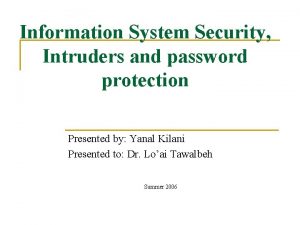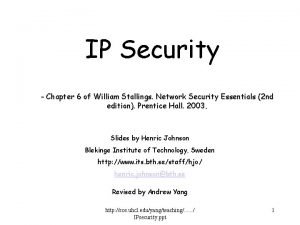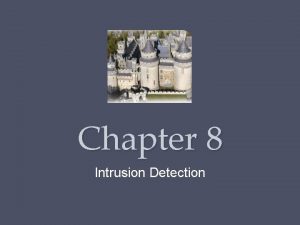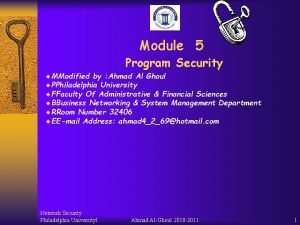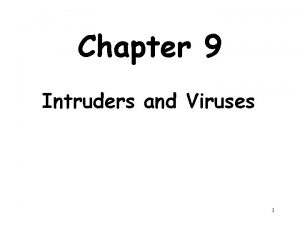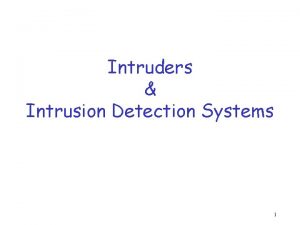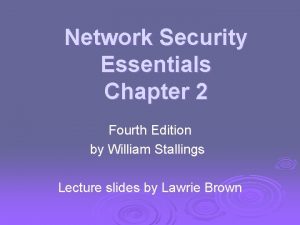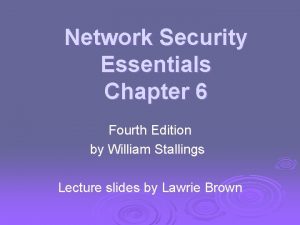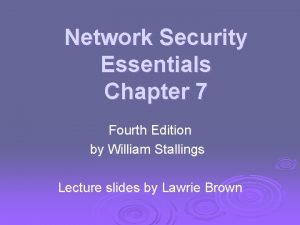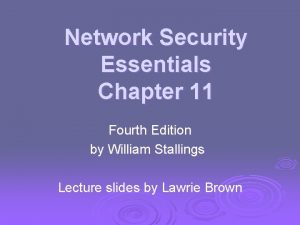Network Security Essentials Chapter 6 Intruders Fourth Edition












- Slides: 12

Network Security Essentials Chapter 6 Intruders Fourth Edition by William Stallings Dr. Bremnavas Ismail Mohideen

Key Objectives of Chapter – 6 • To learn about Intrusion and its techniques • To understand the techniques of Intrusion Detection • To learn about the password management

Intruders • One of the two most publicized threats to security is the intruders. Three classes of intruders: Masquerader • An individual who is not authorized to use the computer and who penetrates a system’s access controls to exploit a legitimate user’s account Misfeasor • A legitimate user who accesses data, programs, or resources for which such access is not authorized, or who is authorized for such access but misuses his or her privileges Clandestine user • An individual who seizes supervisory control of the system and uses this control to evade auditing and access controls or to suppress audit collection

Examples of Intrusion • Performing a remote root compromise of an e-mail server • Defacing a Web server • Guessing and cracking passwords • Copying a database containing credit card numbers • Viewing sensitive data, including payroll records and medical information, without authorization • Running a packet sniffer on a workstation to capture usernames and passwords • Using a permission error on an anonymous FTP server to distribute pirated software and music files • Dialing into an unsecured modem and gaining internal network access • Posing as an executive, calling the help desk, resetting the executive’s e-mail password, and learning the new password • Using an unattended, logged-in workstation without permission

Intrusion Techniques • Objective of the intruder is to gain access to a system or to increase the range of privileges accessible on a system • Most initial attacks use system or software vulnerabilities that allow a user to execute code that opens a backdoor into the system • Ways to protect a password file: One-way functioning • The system stores only the value of a function based on the user’s password Access control • Access to the password file is limited to one or a very few accounts

Password Guessing 1. Try default passwords used with standard accounts that are shipped with the system. Many administrators do not bother to change these defaults. 2. Exhaustively try all short passwords (those of one to three characters). 3. Try words in the system’s online dictionary or a list of likely passwords. Examples of the latter are readily available on hacker bulletin boards. 4. Collect information about users, such as their full names, the names of their spouse and children, pictures in their office, and books in their office that are related to hobbies. 5. Try users’ phone numbers, Social Security numbers, and room numbers. 6. Try all legitimate license plate numbers for this state. 7. Use a Trojan horse (described in Chapter 10) to bypass restrictions on access. 8. Tap the line between a remote user and the host system.

Intrusion Detection • A system’s second line of defense • Is based on the assumption that the behavior of the intruder differs from that of a legitimate user in ways that can be quantified • Considerations: • If an intrusion is detected quickly enough, the intruder can be identified and ejected from the system before any damage is done or any data are compromised • An effective intrusion detection system can serve as a deterrent, so acting to prevent intrusions • Intrusion detection enables the collection of information about intrusion techniques that can be used to strengthen the intrusion prevention facility

Approaches to Intrusion Detection • Statistical anomaly detection • Involves the collection of data relating to the behavior of legitimate users over a period of time • Threshold detection • This approach involves defining thresholds, independent of user, for the frequency of occurrence of various events • Profile based • A profile of the activity of each user is developed and used to detect changes in the behavior of individual accounts • Rule-based detection • Involves an attempt to define a set of rules or attack patterns that can be used to decide that a given behavior is that of an intruder • Anamaly detection: Rules are developed to detect deviation from previous usage patterns. • Penetration identification: An expert system approach that searches for suspicious behavior

Audit Records • Fundamental tool for intrusion detection Native audit records Detection-specific audit records • Each Audit records contains the fields: • Subject, Action, Object, Exception-condition, Resource Usage and Time Stamp

Honeypots • A relatively recent innovation in intrusion detection technology is the honeypots Honeypots are designed to: • Divert an attacker from accessing critical systems • Collect information about the attacker’s activity • Encourage the attacker to stay on the system long enough for administrators to respond • Recent research has focused on building entire honeypot networks that emulate an enterprise, possible with actual or simulated traffic and data

Password Management • Front line of defense against intruders • Virtually all multiuser systems require that a user provide not only a name or identifier (ID) but also a password • Password serves to authenticate the ID of the individual logging on to the system • The ID provides security by: • Determining whether the user is authorized to gain access to a system • Determining the privileges accorded to the user • Used in discretionary access control

Summary • Intruders • Intrusion techniques • Intrusion detection • Audit records • Honeypots • Password management
 Intruders in network security
Intruders in network security William stallings network security essentials 5th edition
William stallings network security essentials 5th edition Cryptographic systems are generically classified by
Cryptographic systems are generically classified by Intruders in system security
Intruders in system security Kr
Kr Business essentials 12th edition
Business essentials 12th edition Classes of intruders
Classes of intruders Intruders use virus signatures fabricate
Intruders use virus signatures fabricate Modulo table
Modulo table Cryptography and network security 6th edition pdf
Cryptography and network security 6th edition pdf Cryptography and network security 4th edition
Cryptography and network security 4th edition Pearson cryptography and network security
Pearson cryptography and network security Project 2 fourth edition
Project 2 fourth edition



